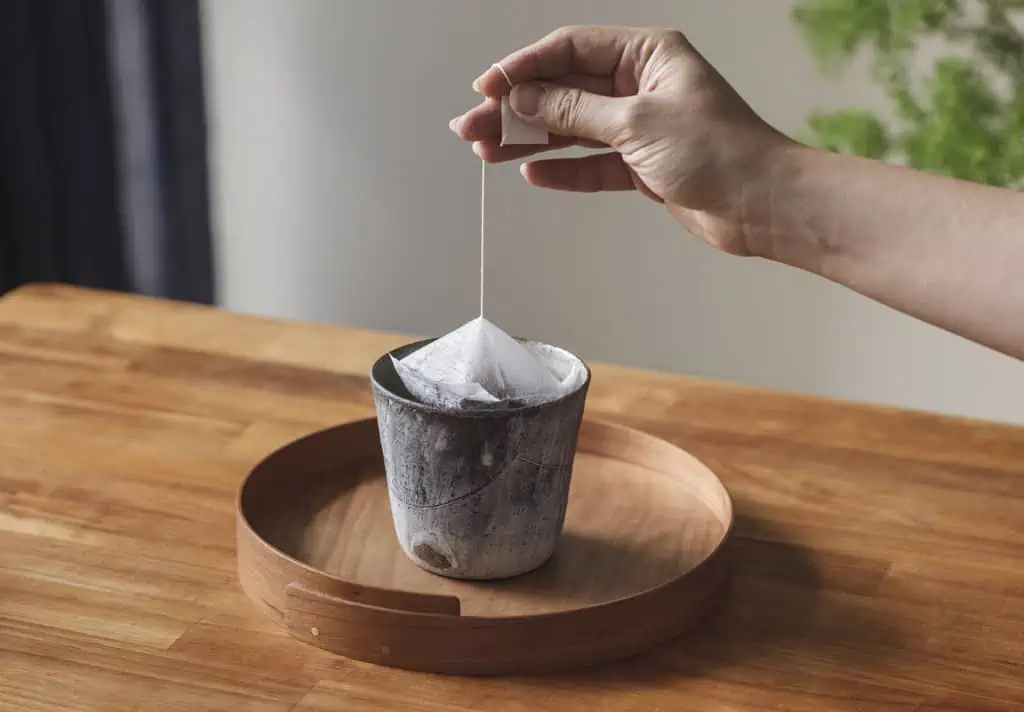
Simon Hsieh’s Bull Demon King is a darker-roasted blend that works well as a steepable brew bag. Courtesy of Simon Hsieh.
Among the many paradoxes in the wide world of coffee, one ongoing question regards ritual versus convenience. Some people like the slow, meditative pour-over brewing method, and others prefer to pre-program a batch brew and have it waiting for them when they wake up. And then there are the times when you don’t have a lot of options — camping, air travel, hotel stays — when just about any coffee tastes good if it’s hot and caffeinated. Recent years have seen an increase in the quality of specialty instant coffee, but let’s face it, it still doesn’t replicate the experience of freshly ground whole-bean.
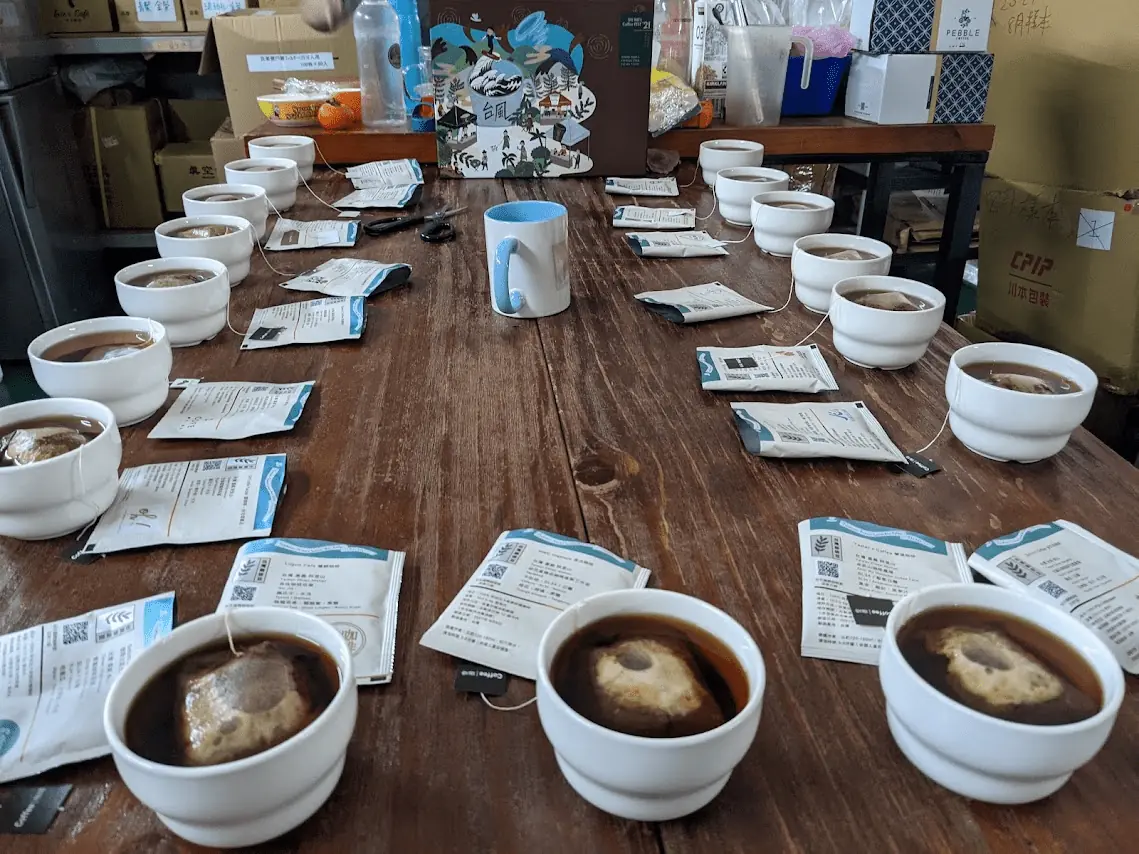
Kakalove Cafe uses brew bags at the cupping table to assess new green coffees. Courtesy of Kakalove
The new kid on the block is brew bags: ground coffee packaged in steepable bags that resemble tea bags. Designed for convenience, brew bags require only hot water and a cup, and they are growing rapidly in popularity, both in the U.S. and in Asia. We tasted 32 brew bags submitted by roasters in the U.S. and Taiwan, of which we review 12 here that scored between 89 and 92. (The score range for the entire pool of 32 was 76 to 92.) Recommended brewing times range from five to eight minutes, depending on the manufacturer.
What was perhaps most surprising was the wide variety of coffee styles available in this format, from straight-ahead house blends to experimentally processed single-origin microlots. Consequently, cupping for this report was a fairly nuanced experience. But in the end, how good are brew bags, really? Do they resemble their whole-bean counterparts? Or are they just a step forward in the quest for convenience?
A Marriage Made in Purgatory
Despite the wide variety of coffee styles, each roaster who makes the foray into brew bags has to decide what to put in that bag, and there are basically two schools of thought. One argument is that darker-roasted coffees perform better with immersion methods, and this idea lends itself to blends that roasters feel comfortable taking a bit darker than the average single-origin coffee, blends they can replicate year in and year out. The counter-argument is that single origins display more varietal character and more transparent terroir, so why not package a coffee that aligns more with what specialty coffee lovers want to drink — typically light to medium roasts of traceable single origins. What coffees work best as brew bags is an interesting question, and both answers are satisfying — until you get into tasting these coffees, where both lines of reasoning reveal their flaws.
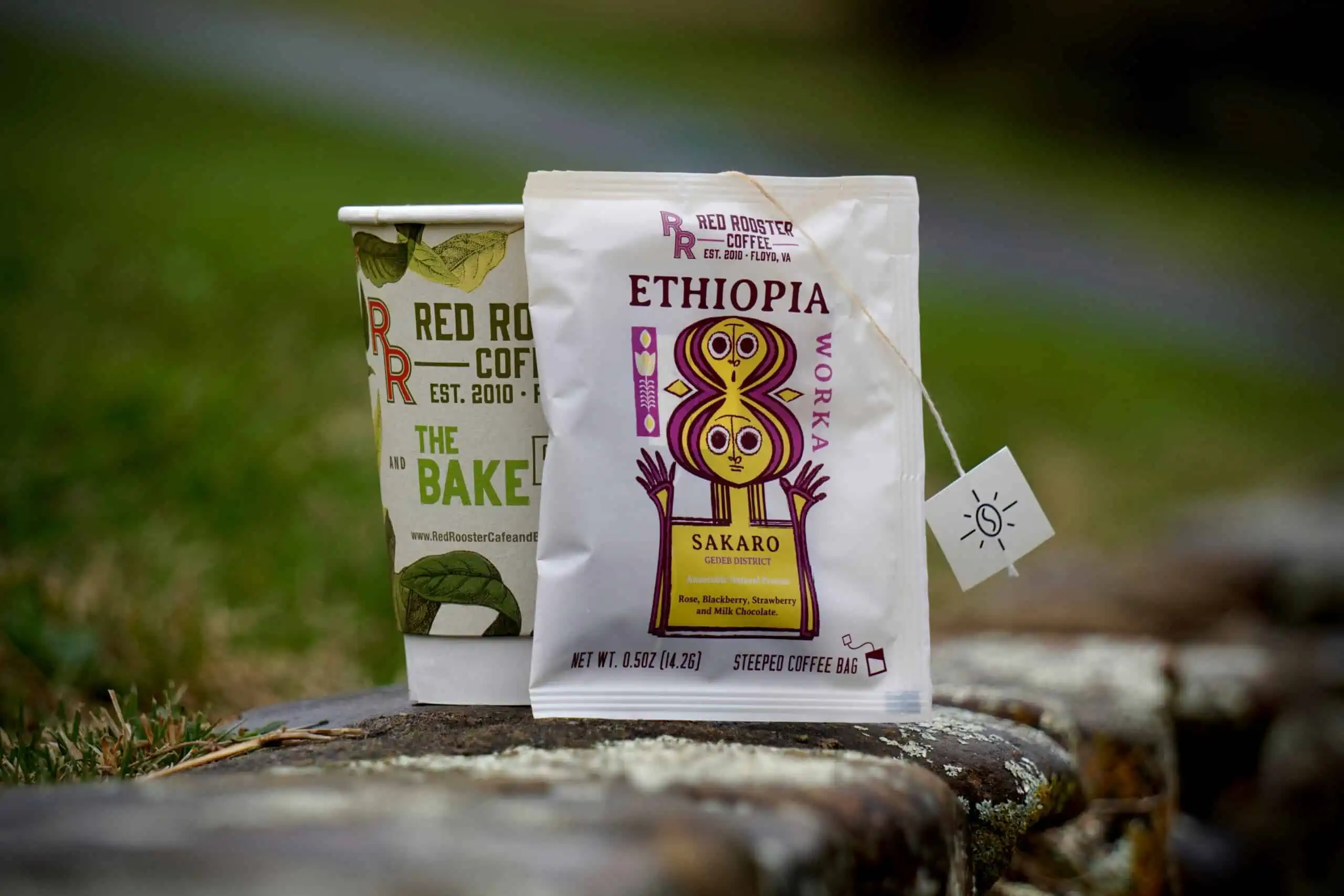
Red Rooster’s Ethiopia Worka Sakaro anaerobic natural performed well in brew bag format. Courtesy of Tony Greatorex
The three top-scoring coffees, all rated at 92 — Mostra Colombia Geisha Spirits, Red Bay Motherland Burundi, and Red Rooster Ethiopia Worka Sakaro Anaerobic — are all single origins, so, it might seem that this camp’s thinking is superior. But given the potential cost differential for roasters to produce certain single-origin bags, the calculation is not so clear. Mostra’s Geisha Spirits brew bag costs $6.80 per serving, due to the cost of the green coffee. Even the least expensive U.S. brew bag reviewed here, the Red Bay Motherland Burundi, costs $1.86 per serving (not counting the Roadmap Road Less Traveled, which was on sale at press time for $1.50 per serving), so it’s not like brew bags are a budget proposition (compared with brewing a cup of whole-bean coffee at home).
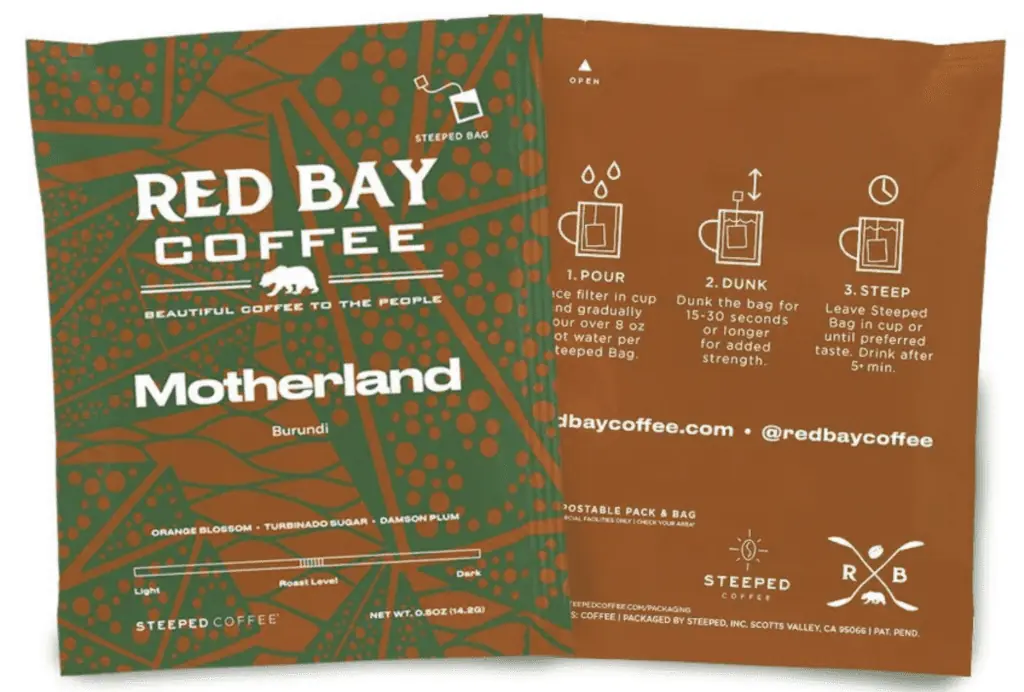
Red Bay Coffee’s Motherland single-origin Burundi translates nicely to the portable brew bag. Courtesy of Red Bay.
Note: For reasons not entirely clear, packaging costs in Taiwan are significantly lower. Two of the Taiwanese brew bags reviewed here cost roughly $1 per serving; the third costs $3.28 per serving solely because of the cost of the green coffee. The average retail price of single brew bags in the U.S. is somewhere around $2.50.
Furthermore, in our tasting, we found that the lighter-roasted coffees needed more steeping time than the darker roasts, causing significant heat loss during brewing. (We didn’t have enough of each sample to test the roast level by instrument on these coffees, so our comments are based on sensory perceptions.) One solution to the heat loss problem is to brew in a travel mug or some other portable cup with a lid — which is likely what you’ll have on hand, anyway, if you’re not at home. But this changes the aesthetic experience significantly, essentially blocking the aroma.
The other single origins that made our top 12 are Evans Brothers Steep ‘N Deep (91), which is 100 percent Guatemala; Kakalove Cafe’s washed Ethiopia (91); Euphora Coffee’s Ethiopia natural (89); and Wildland Coffee’s Limited Edition Light Roast Fair Trade Brew Bag (89), which is a Colombia Pacamara.
Mostra’s Ryan Sullivan makes the case for using a more expensive green coffee in brew bag format: “Geisha is a highly sought-after, expensive, delicious coffee. So, why not see if we can take all those great attributes of Geisha and combine it with the ease of use, convenient coffee tea bag? Something like a coffee tea bag or instant coffee doesn’t have to be cheaper coffee for people on the go. We think there is a market of higher-end coffee drinkers who appreciate great quality coffee for those moments when you can’t stop at your favorite cafe to get a pour-over.”
The downside? In addition to the longer steeping time and consequent heat loss mentioned above, generally speaking, we find the brew bag format mutes aroma, so some of the drama of these special single-origin coffees is blunted a bit. (See below for a direct comparison of three of these coffees with their whole-bean counterparts.)
Blends, on the other hand, are often daily drinkers that don’t always throw off fireworks, coffees that can be replicated each year in high volume and can be designed to show best as darker-roasted profiles. These are generalizations, of course, but the roasters we spoke with who chose blends did so for these reasons. Oliver Stormshak of Olympia Coffee, whose Big Truck Blend scored 90, says, “We chose Big Truck Blend because it’s a little darker roast profile and we found that, for solubility, a darker roast tended to extract easier in this format.” Big Creek Coffee’s Rise Blend, which also scored 90, is another popular house blend, about which owner and roaster Randy Lint says, “We went with our signature blend because it appeals to the broadest range of tastes. Customers enjoy the moderate acidity brought out by a slightly longer roast treatment, and the medium to medium-dark roast level works for most people.”
Simon Hsieh, whose Bull Demon King Blend scored 91, says, “The reason I choose this blend for this version is that it’s easier to get a better result using the immersion method with a darker-roasted coffee. As the hot water is poured in the mug, the temperature keeps dropping during the process. The darker the coffee is, the easier and faster the flavors are coming out from the grounds. Consider this as the same logic as the French Press method; it’s better to use a darker-roasted coffee rather than a lighter one.” We found this to be true, as well, and our solution to the extended brew times necessary for all of these coffees was to brew in a portable travel mug (a Fellow Carter, in this case), with the lid on to retain heat during the brew time, which worked well in terms of getting the proper extraction.
On the flipside, most blends are already accessible sensory experiences with mass appeal in their whole-bean format, so the muting that happens with brew bags puts these kinds of coffees at a disadvantage. But they do, with their accessibility and playful names, offer a great marketing opportunity to pitch this way of drinking coffee to travelers, campers and adventurous spirits of all kinds.
Other examples in the blend camp are Nostalgia Coffee’s Memory Lane (91) and Roadmap CoffeeWorks’ Road Less Traveled (90).
About the Manufacturing Methods
Of the 12 brew bags reviewed here, six were packaged by Steeped Coffee, a company based in Santa Cruz, California, that raised $5 million in 2022 through crowdfunding and continues to grow like gangbusters. Nostalgia Coffee Roasters manufactures in-house and controls every aspect of production, from coffee selection and roasting to grinding and packaging, as does Wildland Coffee (the latter packaged Mostra’s sample as well). Of the three Taiwan samples, Euphora packages in-house, while Kakalove and Simon Hsieh outsource packaging to certified local companies.
We were interested to learn as much as possible about brew bag technology, but because of the proprietary — and competitive — nature of this emerging coffee sector, we were only able to learn the basics of the process. Essentially, roasted whole-bean coffee is ground, de-gassed and packed into steepable, compostable food-grade brew bags and then packaged and, in most cases, nitrogen-flushed for freshness. There are variations on this theme, of course, with some companies making promises about the details of the process, such as how long it takes from receipt of roasted coffee to packaging, and how long it takes to get ground coffee into the brew bags and packaged and sealed.
We were able to learn the most about the methods used by Steeped, Nostalgia and Wildland, the three U.S. companies that manufacture these products in-house. Taylor Fields, founder of San Diego’s Nostalgia Coffee Roasters, says that the brew bag format aligns with her company’s mission to use coffee as a vehicle for systemic change, to help the industry become more diverse, equitable, sustainable and inclusive. She says, “Brew bags tie into that because they bring a whole new market, a new subset of the coffee-drinking population. Brew bags make specialty coffee more accessible to those who feel intimidated in third-wave shops. The format is also sustainable because it eliminates the need for pods and is potentially fully compostable.” (The outer packaging into which the compostable brew bags are sealed can be made of compostable material, although some roasters choose foil to extend shelf life.) Fields adds that as her production volume increases, she is able to ignore the commodity market to work with producers to get them more for their green coffee. Nostalgia has a strategic collaborative partnership with NuZee, also a San Diego-based company, for the final packaging stage.
All three U.S. manufacturers we spoke to described a similar basic process: Freshly roasted coffee is ground to what each considers an optimal micron particle distribution, allowed to de-gas for a pre-determined period of time that varies per company, and flushed with nitrogen when packaged with the goal of creating an oxygen-free environment inside the packet. There’s some explicit divergence where dose is concerned. Steeped uses 14 grams of coffee per bag, while Nostalgia uses 12 and Wildland uses 16. Nostalgia’s reasoning is that 12 grams leaves more room in the bag for water to hit the coffee, and Fields says that agitation is key to good extraction. Zach Frantz, founder of Wildland Coffee, which focuses almost entirely on brew bags, offers a higher dose for a stronger (or larger) cup.
Steeped does have its own line of coffees, but its business model relies heavily on manufacturing brew bags for other roasters. It has a system of “discovery” for potential new roasters, who send in three different coffees or roast profiles to see which fares best in this format. Once the roaster makes a decision, Steeped packages the final product in co-branded bags.
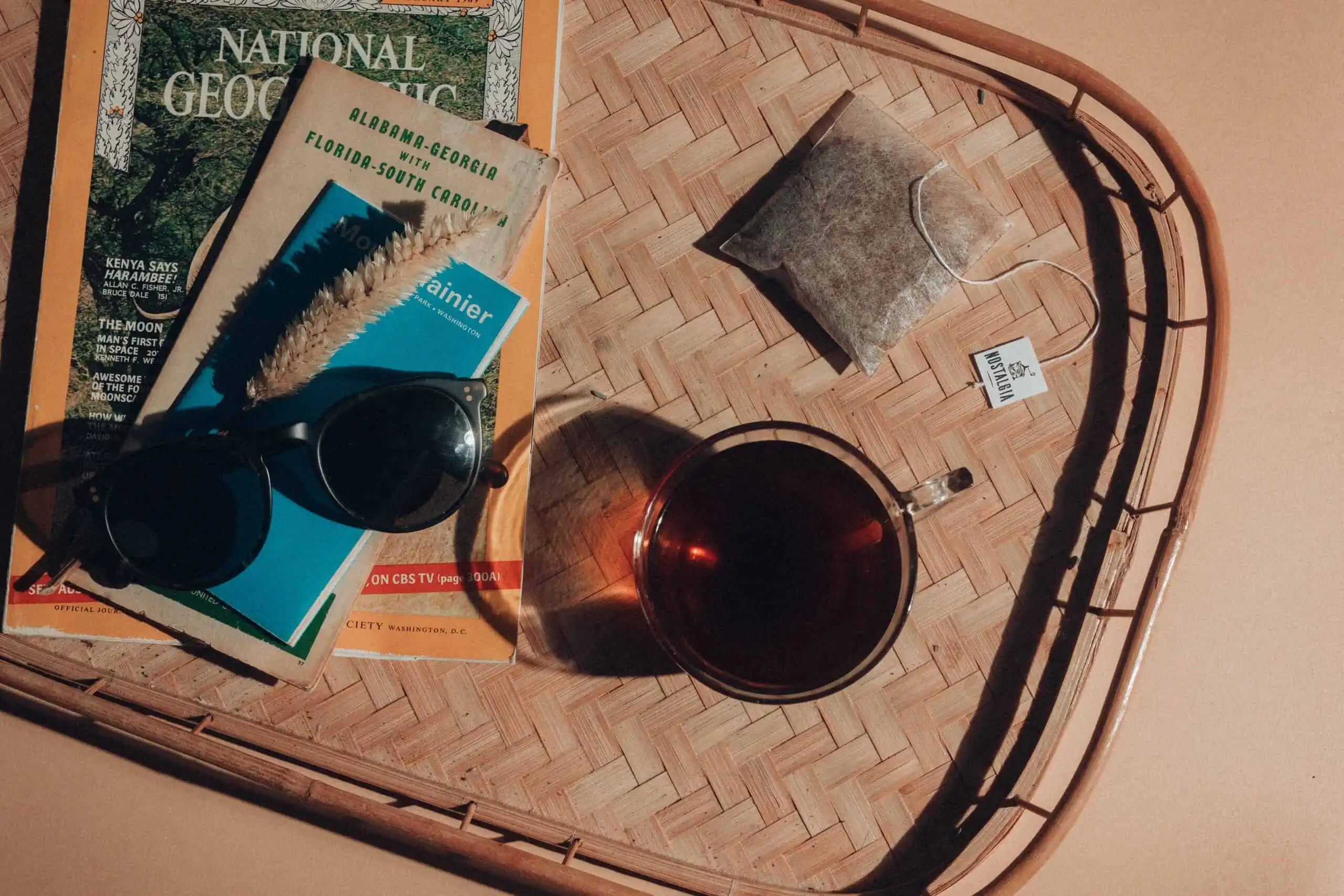
Nostalgia Coffee’s Memory Lane Blend was designed expressly for use in brew bags. Courtesy of Nostalgia.
Steeped uses a compostable bag for its outer packaging, and guarantees freshness for one year, while Nostalgia goes with foil, citing that it provides a better oxygen barrier. Our own small testing revealed that 13 out of 26 coffees packaged in compostable outer layers had oxygen levels between 6.5 and 19 percent, indicating that compostable packaging might not provide as effective an oxygen barrier as suggested by the 12-month freshness claim (more about our oxygen testing below).
Whole Bean vs. Brew Bag Head-to-Head
Because we cup thousands of coffees each year, it’s perhaps not surprising that we’ve been able to taste several of these coffees in whole-bean format. Red Rooster’s Worka Sakaro Ethiopia Anaerobic scored 95 last year for its extravagant complexity. The 92-scoring brew bag version isn’t an altogether different animal; it’s just a bit sleepier and more mellow.
Nostalgia’s Memory Lane scored 93 last year, and our whole-bean review cited the coffee’s balanced fruit and florals, and undercurrents of baking spices throughout. The brew bag version, at 91, is balanced, but all of the sensory categories are turned down a small notch, especially aroma. (Note that this roaster indicated she changed the blend ratio for the brew bag format, so this comparison is a loose one.)
Lastly, we rated Simon Hsieh’s Bull Demon King whole-bean blend at 96 in espresso format in 2021. The brew bag version scored 91. While the two brewing methods are very different from one another, it’s still fair to say that this blend’s decadence, flavor saturation and viscosity when tasted as a brew bag are shadows of the whole-bean original.
These are all exceptionally good green coffees, so it’s not surprising that they performed in the top of their class in this tasting, but knowing where they started in whole-bean terms is an eye-opening gauge when evaluating brew bags as a whole.
The Question of Oxygen
We tested the oxygen present in each of the 32 brew bags we tasted. Despite elaborate efforts by all manufacturers to keep staling oxygen out of the bags — and offer a shelf-life of up to one year — we found mixed results.
This is important, of course, because of the freshness factor. What’s clear is how much the presence or absence of oxygen affected sensory outcomes. Ten out of the 12 brew bags that earned the highest scores contained no oxygen; two contained 12 percent. Brew bags that scored below 89 contained percentages of oxygen ranging from zero to 19. We know that oxidation is bad for coffee over time, but it isn’t possible to reach any blanket generalization from these limited results given that this is our first foray into the brew-bag segment.
Roasters Weigh In on the Genre
How do roasters feel about this new(ish) coffee format?
Melissa Scholl of Roadmap CoffeeWorks says, “We debated adding a quick-brew option for months. We started roasting 32 years ago and were one of the first to roast only to order, date each roast, and ship the same day. So, this was a big change. But after exploring the options, we had to admit that technology had indeed progressed over the last three decades, and we felt this was now something we could do with integrity that our customers would find helpful and enjoy. The only negative has been some price resistance since the packets are more expensive than traditional instant coffee. Our customers readily buy $35-a-pound coffee beans, but a $2.50 cup of ‘instant’ coffee is a new idea. We sell single packets so that folks can try it easily.”
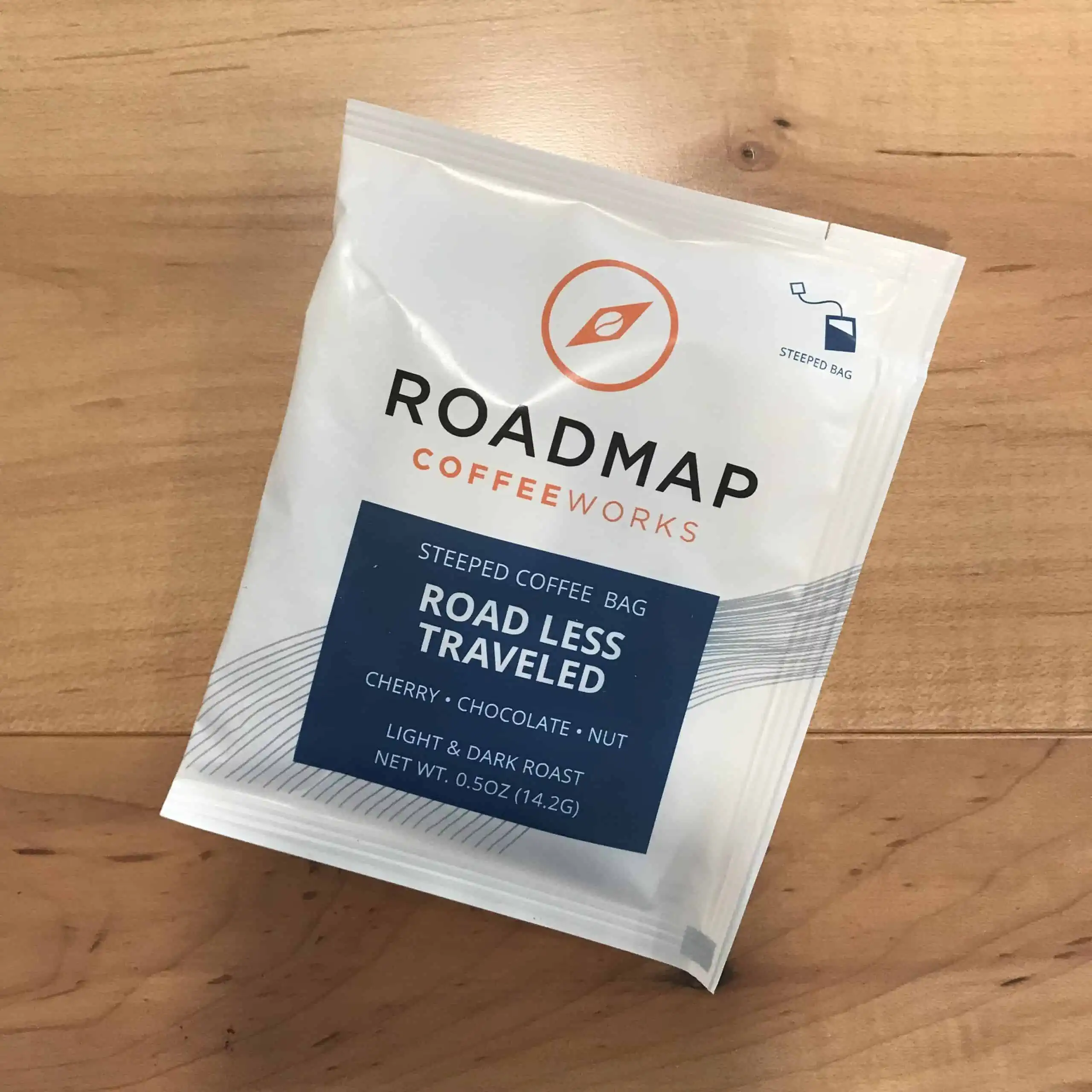
Road Less Traveled is a popular blend at Lexington, Virginia’s Roadmap CoffeeWorks. Courtesy of Roadmap.
Hsieh says, “I want to expand my customer base and also to extend my market to overseas. Not everyone wants to buy a lot of gadgets to perform ceremonial brewing steps to get a good cup of coffee, but many still would like to get a good cup of coffee in a much easier way.”
Caesar Tu, of Kakalove Cafe, doesn’t love the brew bag format — he thinks it waters down the flavor of any coffee, and he also finds it difficult to showcase the light-roast single origins he loves in this way — but he knows that many people like the convenience, so he stocks them. It costs him only about 30 cents USD per bag to manufacture them, so it’s not a big financial risk. And his single-origin washed Ethiopia, which isn’t fancy or flashy but is true to its gently bright, floral Ethiopia style, scored 91.
Better Than Instant, Not as Good as Whole Bean
Our experience of these 12 coffees was clear: They’re better than the instant genre, generally speaking, with a much more lively and viscous body and more flavor saturation in the cup. But they don’t offer the full sensory experience of whole-bean coffees. Our comparison with the whole-bean versions of three of these green coffees, while limited, leads us to think the score differential between the two formats may average around two to three points. This makes sense given that the final product is ground coffee. Even though attempts to reduce oxidation through nitrogen flushing and impermeable packaging are partly effective, the lower scores for brew bag versions of some coffees means there’s more work to be done in this area.
We also found aromas — one of the great pleasures of grinding fresh beans and engaging in the pour-over ritual — to be fairly muted across the board. But if you dial in your steeping time for the kind of extraction you prefer, the flavor in these brew bags is pleasing, much more than you’d expect from a “convenience” coffee. So, next time you find yourself waking up in the woods, on a red-eye flight, or in a hotel with only a pod machine in the room, try one of these brew bags and see what you think.

